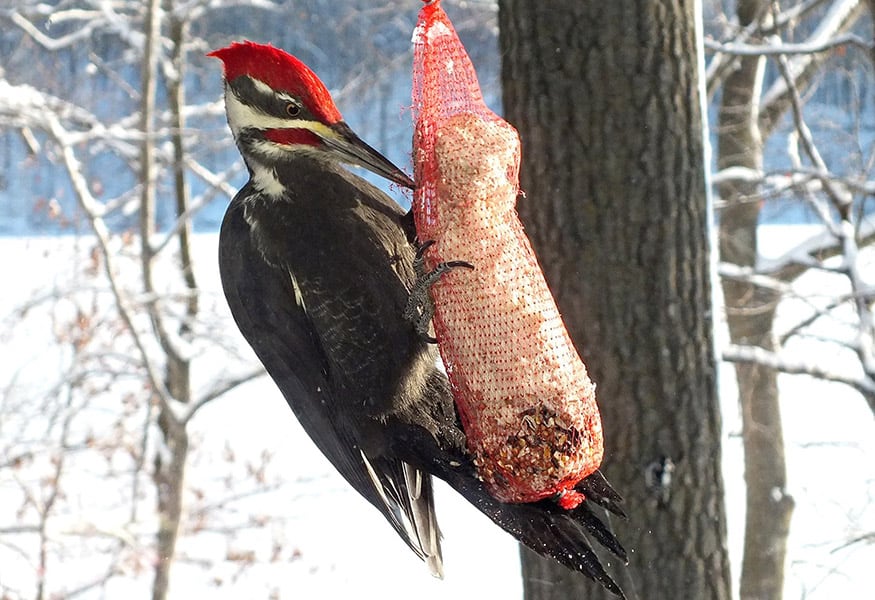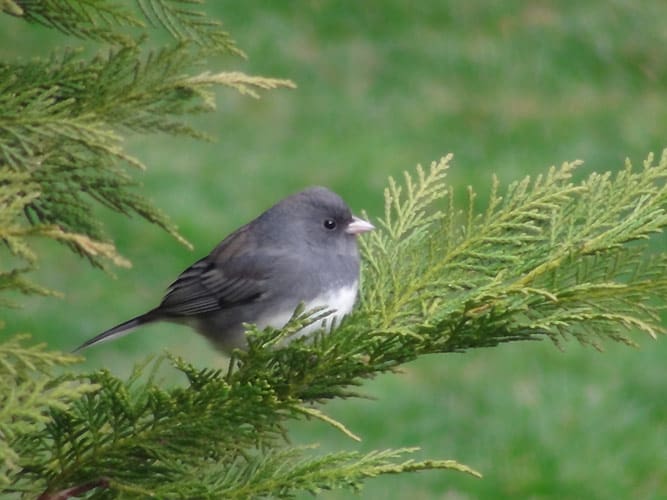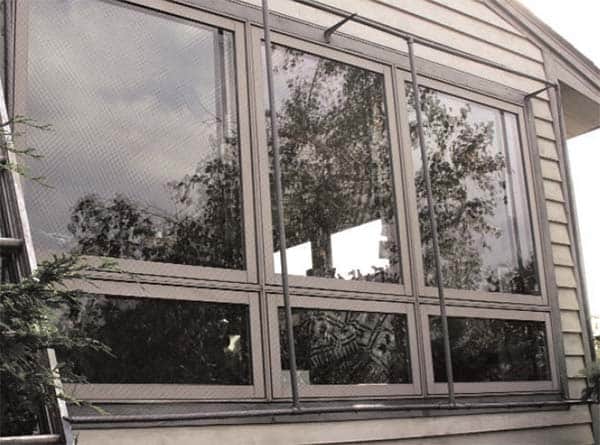Build an Easy Box for Golden-fronted, Red-headed, and Hairy Woodpeckers
Download detailed plans you can use to build your own woodpecker box.
The plans for this box were taken from The Original Birdhouse Book, which features 26 birdhouse, nesting shelf and nesting box plans you can build.
Tools You’ll Need
- Square
- Pencil
- Ruler
- Saw
- Plane
- Rasp
- Brace, with 1/2-in. bit and expansion bit up to 2-1/2 in. or keyhole saw
- Drill, with assorted small bits
- Hammer
- Straightedge
Materials
- Golden-fronted, Red-headed, and Hairy Woodpecker Box
- Cedar boards or exterior plywood, 5/8 in., 36-1/4 by 17-1/4 in.:
- Bottom—6 by 6 in.
- Sides (2)—each 14-3/4 by 13-3/4 by 6 in.
- Back—17 by 7-1/4 in.
- Front—14 by 7-1/4 in.
- Roof—9-1/4 by 9-1/4 in.
- Fourpenny galvanized box nails
- Sixpenny galvanized box nails (2)
- Galvanized nail or right-angle screw hook, about 1.5 in. long
- Caulking compound
- Sixteen-penny galvanized nail
- Post (optional)— 4 by 4 in. or 4 by 6 in., 14 ft. long galvanized metal pole
- Strapping brackets for mounting box
- Predator baffle (pole- or post-mounted)
Instructions
- After you have looked over the drawings and decided which box or boxes to build, lay out the parts, with a square and pencil, on the weather surface. Saw out the pieces, plane the splinters, mark the parts, and put them aside. If the interior surface of the front, back, and sides is smooth, roughen it—really scar it up—with the corner of a rasp. This helps young birds gain a foothold when trying to climb to the hole when exiting the box. Cut back the corners of the bottom piece.
- In the back panel, drill a 1/2-in. hole 2 in. down from the top and centered horizontally. (On the downy woodpecker box, center the hole 1 in. down.) Bevel the back 1/8 in. toward the interior surface. On the front panel, bevel 1/8 in. toward the weather surface.
- Drill the entrance as shown for each box, using a keyhole saw or expansion bit on the larger boxes. If you have neither, then draw the circle and drill a series of 1/2- to 1-in. holes just inside the circumference. Chew out the hole with a rasp, rounding the edges. Woodpeckers won’t mind a few irregularities.
- Draw a line across the interior surface of the back, 2-3/4 in. up from the bottom. Extend it across the edges and the weather surface.
- Next, draw a line across the interior surface of the front panel, 1 in. up from the bottom, and extend it over both edges.
- Draw 1 more line across the interior surface of the right side panel, 1 in. up from the bottom, and extend it across the edges.
- To begin assembly, start 2 nails on the weather surface of the right side panel to come out 1/4 in. below the line. Do not get the nails too close to the edges of the side panel, because the bottom edge, to which you will nail the side panel, has the corners cut off. Place the “decornered” bottom on edge, against a wall. Lay the side panel across, with the line matching the interior surface of the bottom. The wall will keep the 2 pieces flush. Drive the nails part way in.
- Place the unit on its side edge and lay the back panel on, flush with the side piece. Match the lines. Put 2 nails through the back, part way into the edge of the side panel. The top of the side panel should be 1/4 to 3/8 in. below the back. Bring the outer corner of the bottom into position. Drive the nails part way in. Put another nail into the bottom, near the inner corner. If everything lines up, drive in all the nails.
- Turn the unit on its back and lay the front piece on, flush with the side. Match the lines. Drive 2 nails through the front, part way into the edge of the side. Check the bottom for alignment. Pull it into position, hold, and drive a nail part way in the outer corner. Put 1 more nail into the inner corner. Check the side and front panel. There should be a 3/8-in. drop below the bottom to allow for rain drip.
- Lay a straightedge across the front and back panels. There should be a 1/4 to 3/8-in. gap between the top of the side and the straightedge. If it all fits, drive in all the nails.
- Slip the left side panel, which will be the door, into place and check it for fit, lightly shaving off the edges with a sharp plane if the fit is too tight.
- Mark 1 in. down from the top of the front panel near the edge. Draw a line at 90 degrees from this point, across the left side panel. Following the line, drive a sixpenny nail through the front panel and part way into the edge of the side panel. Repeat through the back panel. Before driving the nails all the way in, test the door hinge by pulling from the bottom.
- Tack the door shut and drill a small hole into the edge, through the front panel near the bottom. Slip in a lock nail or use a right-angle screw hook to hold it shut. Remove the temporary nail.
- Now for the roof. Run a strip of caulking compound along the beveled edge on the back panel. Set the box upright, using a block under the front edge. Start 2 nails in the rear portion of the roof, to connect with the top edge of the back panel. Place the roof in position, flush with the back and with an equal overhang on both sides. Drive the nails part way in. Line up 2 more nails to connect with the top edge of the front panel. Drive them part way in. Check it over, then drive in all the nails. Do not put any nails through the roof, into the sides.
- To mount the box on a post or snag, drive a sixteen-penny galvanized nail at an angle in the desired location. For flickers and downies, the box should be 6 to 20 ft. above the ground; for red-headed, golden-fronted, and hairy woodpeckers, 12 to 20 ft. above the ground. Hook the box through the 1/2-in. hole in the back. Put 2 more nails into the edge, where the back panel extends below the bottom. Do not drive the nails all the way, in case you want to change locations later on. Remember to use a predator-proof baffle mounted below the box in areas where nest box predators are prevalent.
Suggestions
Many times woodpeckers will pass up what seems to be a perfectly suitable box in order to excavate their own nest cavities. Here are a few suggestions that might help to improve your success.
- For larger birds such as flickers and golden-fronted woodpeckers, mount the box in the sun where it can be seen easily. For hairy woodpeckers and downies, be sure the tree trunk site is free of nearby limbs.
- Be sure the box is high enough for each species, as indicated in the instructions. Put a predator guard on the post (see “Predators and Competitors” starting on page 72).
- Woodpeckers, particularly flickers, generally have a strong desire to get in and dig. It’s an important part of their courtship and breeding cycle. Give them something to do by filling the nest box, floor to ceiling, with tightly packed wood chips (sawdust works, too, in areas that receive little rain. In wet areas, sawdust soaks up and retains moisture, which can hinder development of eggs and young birds). After they toss out all the material, add another four inches.
- If there are no takers, tack some bark on the outside of the box so it blends with nearby tree trunks. This may help to satisfy house-hunting woodpeckers.
- Once you know from your visits that the woodpeckers are on eggs or that the eggs have hatched, resist the urge to peek into the nest. Nestling woodpeckers older than 12 days from hatching are excitable and may attempt flight before they are ready.
- Flickers will sometimes attack a house, particularly one with shake siding. Try a flicker box over the area they are pecking. The box will also have a hollow sound when pecked, which may have been what attracted them to the shakes.
- For the different species of woodpeckers that live in your neighborhood, build a number of boxes and place them in several locations. The woodpeckers will decide which is best. And you never know—other desirable birds may be attracted.





Mounting the box 20′ above ground makes it rather inaccessible for us old folks. Any suggestions for making it retrievable without using an extension ladder?